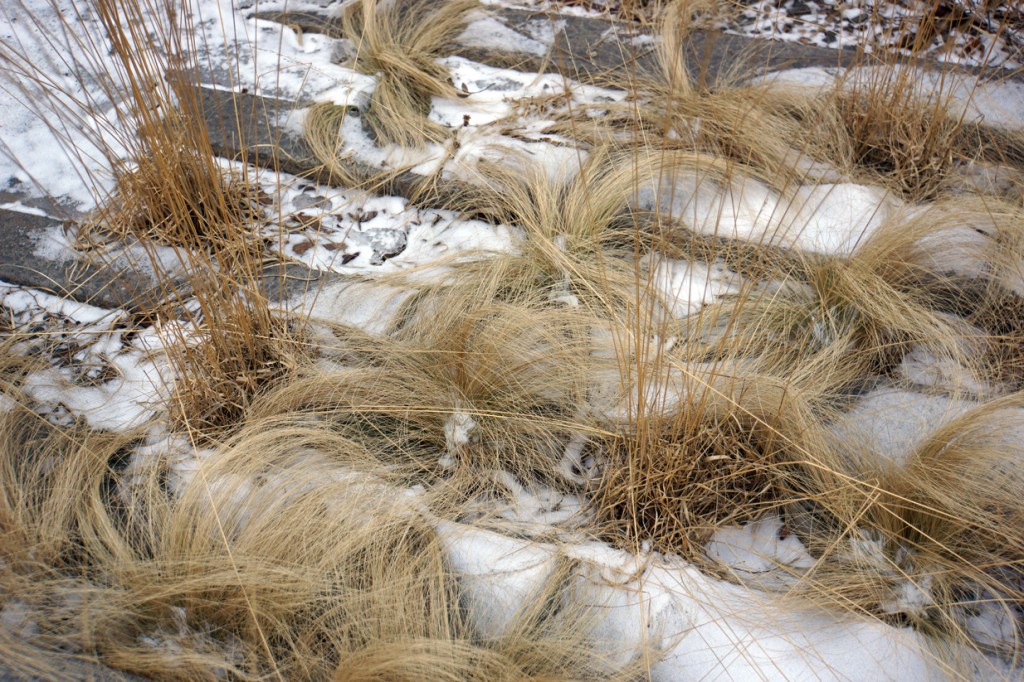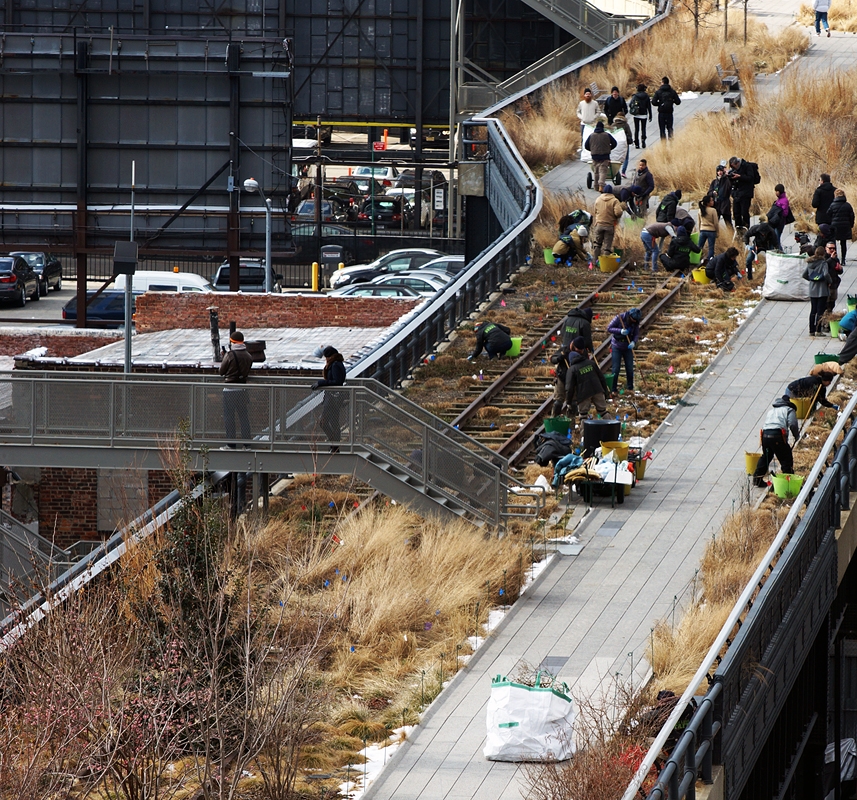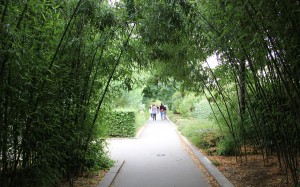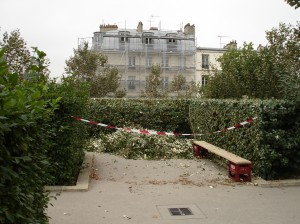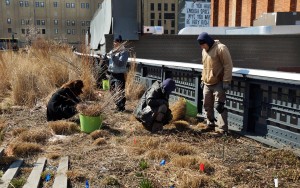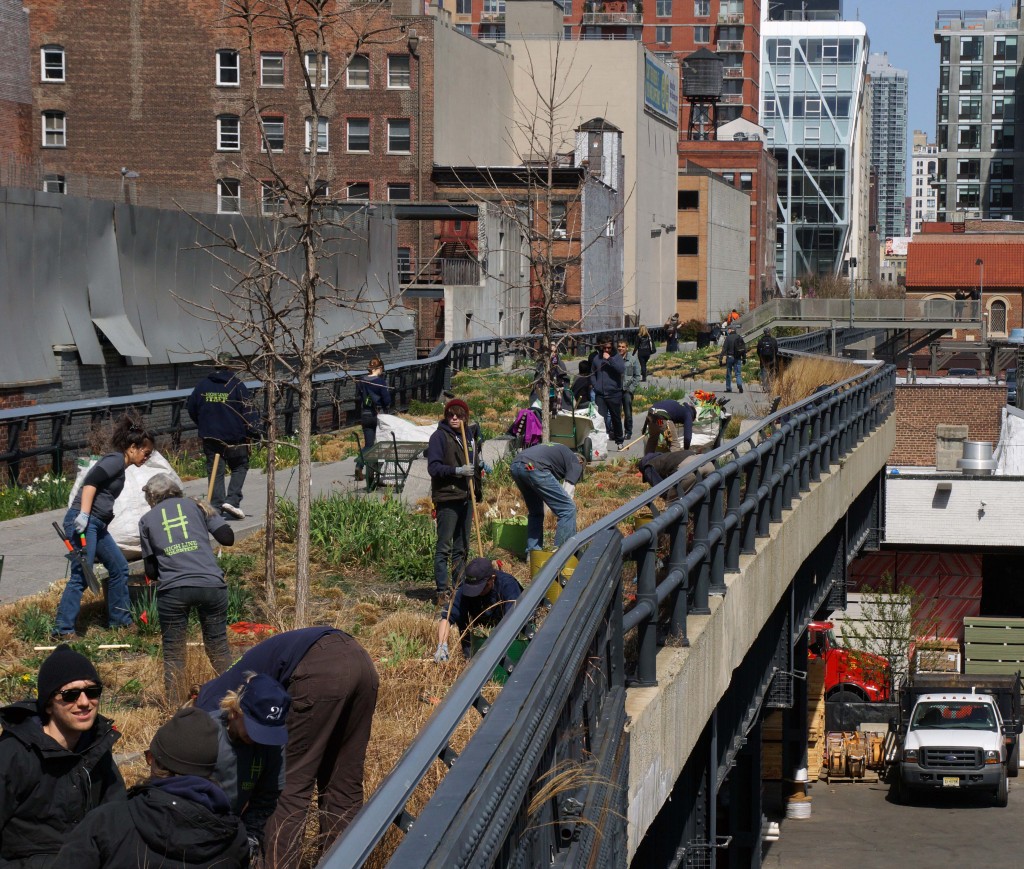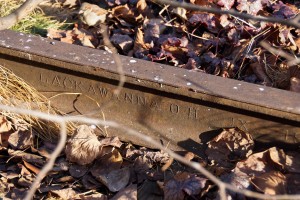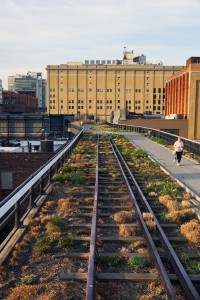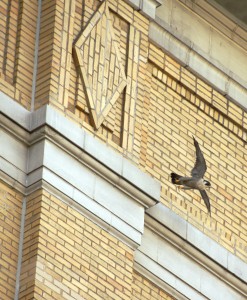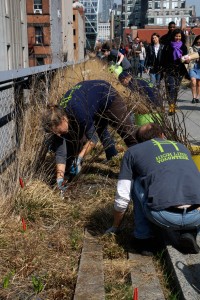On Gansevoort Street, at the southern end of the park, the new Whitney Museum of American Art is slowly taking form, shedding its temporary external panels every few weeks to reveal expansive windows that promise abundant light and stunning Hudson River views. At the northern end, a whole new city is rising around the Rail Yards. The future headquarters of Coach is a work-in-progress that’s already looming over the park and eventually will straddle it, creating a tunnel along the spur at 30th Street. In between these two anchors — one cultural, one commercial — and on both sides of the High Line, construction sites abound: business and residential, retail and dining, even transportation: the new No. 7 line will have an entrance just under the park. [continue reading…]
piet oudolf
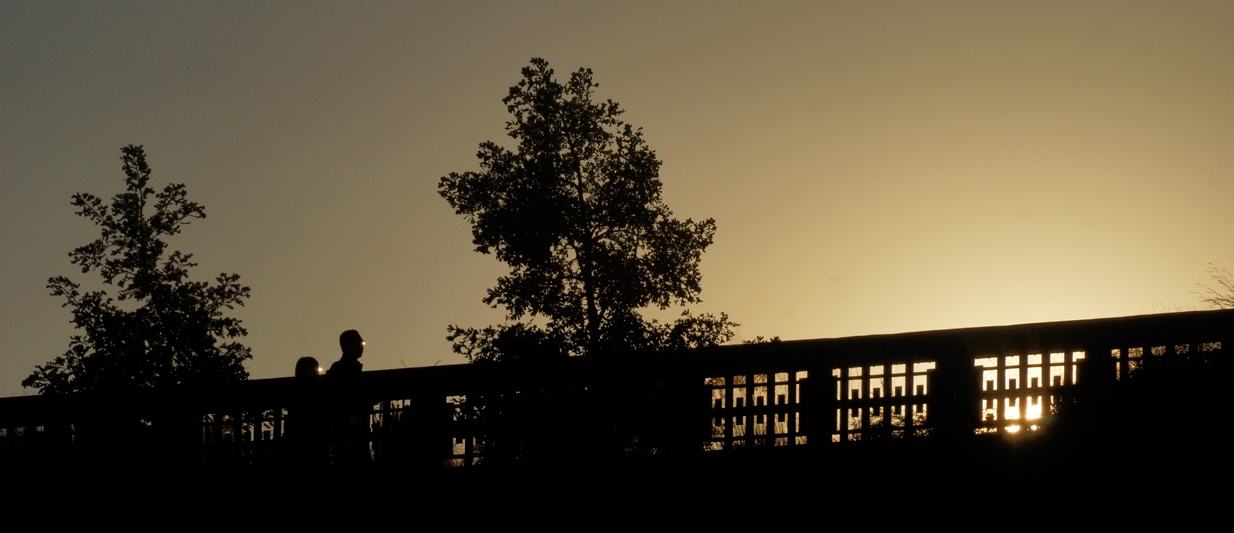 Earlier this week Joshua David and Robert Hammond, co-founders of Friends of the High Line, received the prestigious Vincent Scully Prize. Awarded by the National Building Museum in Washington, it was created to recognize extraordinary practice, scholarship or criticism in architecture, historic preservation and urban design. The namesake of the award and its first recipient was an art history professor at Yale University. New Yorkers may remember Scully best for his comment about the atrocity that replaced the majestic, Beaux-Arts Penn Station that was torn down fifty years ago this month: “One entered the city like a God. One scuttles in now like a rat.”
Earlier this week Joshua David and Robert Hammond, co-founders of Friends of the High Line, received the prestigious Vincent Scully Prize. Awarded by the National Building Museum in Washington, it was created to recognize extraordinary practice, scholarship or criticism in architecture, historic preservation and urban design. The namesake of the award and its first recipient was an art history professor at Yale University. New Yorkers may remember Scully best for his comment about the atrocity that replaced the majestic, Beaux-Arts Penn Station that was torn down fifty years ago this month: “One entered the city like a God. One scuttles in now like a rat.”
Paul Goldberger, in introducing the co-founders, spoke about the impossibility of the High Line, and “all the reasons why it couldn’t work.” I recently re-read David and Hammond’s High Line: The Inside Story of New York City’s Park in the Sky, the tick-tock of the entire reclamation and preservation story, and “impossible” is just the right word. The book is an unlikely page-turner, and I recommend it as a tonic for these very particular days when our government is shut down and it’s hard to believe in anything good in the public realm. The existence of the High Line is a miracle, pure and simple, and it shows that innovative, creative, beautiful — and impossible — things can be done in our communities.
There are dozens of people who helped make the High Line the place that it is: early supporters, both in and out of government, who gave invaluable advice and support to the fledgling Friends of the High Line; landscape architect James Corner and his team; architects Diller Scofidio + Renfro; Dutch plantsman Piet Oudolf; and a staff of incomparably talented and dedicated staff, both in the garden and the back office. David and Hammond are like dual conductors of a symphony orchestra: not the men who make the music but the ones who enable it. It’s worth watching their speech online — click here for the video on YouTube — because it not only recaps the whole story but it also conveys the energy and optimism that have driven the entire project from its earliest days. It’ll put you in a good mood, I promise.
David closes his comments by quoting the second winner of the Vincent Scully Prize, the great Jane Jacobs, whose love of neighborhood and city were inspirations to both men. But along this urban greenway that did so much to preserve a sense of wildness in the center of our thriving, growing, city, I hear Scully’s voice resonating. In the 1960s, he testified in hearings to protest Con Edison’s plan to build a massive power plant at Storm King on the Hudson River, some 60 miles north of Gansevoort Street, “at the very threshold of New York.” The victory to preserve Storm King marked the beginning of the modern environmental movement; it was the first miracle story in New York State, and every activist since has carried a bit of the mountain in his soul. Here’s what Scully said, some 50 years before the opening of the High Line:
“Storm King…is a mountain which should be left alone. It rises like a brown bear out of the river, a dome of living granite, swelling with animal power. It is not picturesque in the softer sense of the word, but awesome, a primitive embodiment of the energies of the earth. It makes the character of wild nature physically visible in monumental form. As such it strongly reminds me of some of the natural formations which mark sacred sites in Greece and signal the presence of the Gods; it preserves and embodies the most savage and untrammeled characteristics of the wild at the very threshold of New York. It can still make the city dweller emotionally aware of what he most needs to know: that nature still exists, with its own laws, rhythms, and powers, separate from human desires.”
NOTE: a version of this article first appeared on the blog of the American Library of Paris on 26 March, 2013.
I’m headed to Paris this week to give a talk at the American Library about the High Line. As my plane takes off, an important rite of spring will be ending in New York’s “park in the sky”: the March Cutback. This makes it a perfect time to visit the High Line’s muse and inspiration, the Promenade Plantée, the world’s first mile-long garden built on an old railroad viaduct. Like the High Line, the park in Paris – also known as the Coulée Verte – floats 30’ above the busy streets, cutting through the entire 12th arrondissement.
For all their similarities, the two parks are quite different. Unlike the Promenade Plantée and most other formal gardens, the plants on the High Line are not clipped and pruned at the onset of Fall, when cold weather arrives. Instead, they are left alone to complete the full cycle of their lives. Piet Oudolf, the Dutch horticulturist who created the High Line’s garden design, believes that plants should be interesting and beautiful to behold throughout all the stages of their growth. As he once told a reporter, “Dying in an interesting way is just as important as living.”
For the High Line, Oudolf chose plants that recall the beautiful and richly diverse wild garden that grew on the abandoned viaduct after the trains stopped running in 1980. He selected some 250 species of perennials, grasses, shrubs, vines and trees, both native and exotic, that would change in striking ways throughout the year, delighting and engaging a visitor no matter what the season.
I expect to arrive in Paris with a few blisters and even some dirt beneath my fingernails. Every year, throughout the month of March, Friends of the High Line – the group that saved, built and now runs the park – enlists an army of volunteers who work elbow-to-elbow alongside the gardening staff to cut back around 100,000 plants in preparation for the new growing season. The volunteers approach the job like good postal service employees: in rain, snow, sleet, and hail (I once even worked through a thunderstorm) we clip, cut, rake, and haul, filling enormous canvas bags with cuttings that will be trucked to Staten Island where they will rest in peace in giant piles, before becoming mulch for another garden.
The founders of Friends of the High Line, Robert Hammond and Joshua David, knew the Promenade Plantée well, and greatly admired it. But they had a very different idea for the park they would create in New York. At its heart, the High Line was intended to recall the old railroad, horticulturally as well as architecturally. Not only is it filled with a great many plants that are natural pioneers along abandoned railroads and other industrial ruins, but the train tracks themselves got a starring role: they were embedded in the pedestrian pathway and garden beds, where they enunciate the gentle curves that engineers of the New York Central once line navigated back in the day when the railroad was king. Crushed stones were placed in garden beds to suggest railroad ballast, and throughout the park a visitor encounters old signal lights, loading docks, meat hooks, and other elements once integral to the railroad’s freight operation.
Paul Van Meter, a horticulturist, railroad historian, and co-founder of VIADUCTgreene in Philadelphia, notes that the stylish, highly ornamental garden types on the Promenade Plantée – its lush, bamboo forest, sheared hedges, arcades of roses, allé of trees – are by contrast “representative of French classicism, with a focus on decoration rather than function.” He also points out that the elevated garden in New York “signals an important change in American tastes which inclines toward the heavy use of perennials and wildflowers. It’s no coincidence that Robert Hammond grew up in San Antonio, Texas, not far from the Lady Bird Johnson Wildflower Center, whose 1999 grand opening in part led Americans to discover the inherent beauty of wildflowers and grasses so they would invite them into their gardens.”
As they came to “re-see the beauty of ‘native’ wildflowers,” Van Meter explains, “the post-World War II designers, like my great friend and mentor Wolfgang Oehme and more recently, of course, Piet Oudolf, gained (re)appreciation for a certain kind of controlled wildness. With that notice came availability of plants in previously unprecedented variety and sizes. And a revolution was on.”
When my friend Melinda Zoehrer, a horticulturist at the University of Delaware, learned I was writing about the High Line’s Cutback in relation to the Promenade Plantée, she sent me a photo of the Parisian counterpart: a lovely — and very formal hedge — that had recently been pruned. She pointed out the string that cuts a perfect horizontal line from one end of the hedge to the other (click the photo to enlarge it). This image, alongside I photo I shot on the High Line last week (below), perfectly illustrates the difference between the classicism of the French garden and the wildness of the American one. These photographic glimpses offer a way of understanding a garden not by what grows there, but by how what grows is ultimately cut back or removed.
So: two gardens made from old railroads, each a reflection of its history and culture. For me, the great delight of these places is that they form one long, linear, observation deck, providing a stunning and original perch from which to view a much-loved city. In the 1850s, Frederick Law Olmsted and Calvert Vaux conceived their first creation, Central Park, as a grand escape from the city: a place where anyone, no matter how rich or poor, could rejoice in fresh air and beautiful scenery. Today, parks like the Promenade Plantée and the High Line do just the opposite: they console, inspire, and delight us by taking us deeper into the city, through a tunnel of roses (as in Paris) or a prairie of wild grasses (as in New York).
These gardens have had a powerfully transformative effect on the way we think about nature, urbanism, and culture. Just as the Promenade Plantée inspired the High Line, so is the High Line serving as a model for other innovative projects around the world. In London and on Manhattan’s Lower East Side planners contemplate underground parks that deploy 21st century lighting systems and could support agricultural projects like a mushroom farm. Philadelphians dream of a park in two sections that embraces the full range of an urban railroad’s historic pathway: an elevated garden bathed in natural light and a submerged series of graffiti-adorned tunnels. Work continues on the Beltline in Atlanta, a project that is so big – it runs for 22 miles – it can connect as many as 45 different communities.
Virtually every city in the world has a railroading past, and rather than bury or tear down that history, urban planners and community leaders are today seeking to identify the cultural heartbeat of their project, and bring it life as a great public space and grand connector.
The Cutback in New York and the rosebuds in Paris remind us of such renewal, and give cause for much celebration and joy.
What a way to spend a morning. Or a lunch hour (which, in New York, is two hours minimum). If you’re still at your desk on these beautiful, crisp and occasionally downright hot days, you’re missing something great: working with clippers on the High Line.
Just about every day dozens of volunteers are out there, cutting back the grasses and dead stalks that are Piet Oudolf’s signature. Oudolf, the Dutch planstman who designed the park’s horticultural plan, once famously told a reporter that “brown is a color.” Here on the High Line, unlike so many other gardens around the world, the plants are left alone during the winter, and they present an always interesting landscape of different shapes and textures: spiky, smooth, straight, twisted, standing at attention, weeping in a corner. There’s lots of brown for sure, but also other colors: blazing yellow witch hazel, pale green Corsican hellebore, silver leaves on little bluestem grass, red berries on holly trees.
In Spring, the whole place gets a haircut, and it takes a village. It’s a wonderful way to pass a few hours: clipping, hauling, scraping, cleaning. Unlike that meeting you just attended where everybody jawboned and nothing really happened, you can watch your progress as you go: whole swaths get cleared away and suddenly, with the dead matter gone, the rails stand out as clear as day.
Every year the Spring Cutback is the most vivid reminder we have that the High Line was once a working railroad. When I was there on Monday, clipping and clearing around a set of old tracks in the Chelsea Grasslands, I was reminded of how Isabel Church, wife of the landscape painter Frederic Church, called the Catskills “the shy mountains” because they were so often hidden by clouds and invisible to the many visitors that the Church’s received. Here in Manhattan we have the shy rails. Over the course of the year, beginning in spring, the grasses, shrubs and perennials take over, and the tracks begin to disappear under all the new growth. But today, and for the next month or so, you can see them boldly running up and down the entire extent of the park. Look closely and you’ll see the name of a railroad and year the track was manufactured stamped into the steel: LACKAWANNA OH 1926 is lurking somewhere between 18th & 20th Street.
If you missed the Cutback this year, put it on your calendar for 2013. We all know about the irksome inevitability of death and taxes; the happier thing to count on is rampant, glorious, unruly plant life on the High Line. In addition to spending time working outdoors in the big city you’ll also get the chance to hang out with Friends of the High Line’s incredibly great gardening staff. They’re among of the most knowledgeable, patient, cheerful, hard-working people I’ve ever met. I know I speak for many volunteers when I say that working alongside them feels more like a privilege than a task.
After a day of the Cutback you might have an aching back, but a full heart is guaranteed.
If you’re a regular High Line visitor you know the magnificent peregrine falcon who has taken up residence at the Drug Enforcement Agency building on 17th Street. I’ve been photographing this bird for more than a year, and a few months ago saw him perched with his mate. Occasionally he cries out in piercing bursts, but lately he’s been sitting very quietly for hours at a time, watching the world go by. Today I caught him leaping off his ledge to go soaring over the Hudson River.
The Hudson is a major migratory corridor and some 300 species of birds – songbirds, raptors, waterfowl, shorebirds – pass overhead each year. One reason the abandoned rail line became such a bountiful wild garden is because birds carried seeds here from all over the country, both on their feathers and in their droppings. In his plan for the High Line landscape designer Piet Oudolf included many of the prairie grasses and perennials that first came here courtesy of birds.
My theory is that the falcon is transfixed, as so many of us are, by the Spring Cutback, a great event that brings dozens of volunteers to the High Line to cut back all those perennials and grasses and allow for new growth.
There are 100,000 perennials and grasses in the park, but unlike many gardens, the plants are not deadheaded in the fall. An essential aspect of Oudolf’s planting design is the presence of seed heads in winter, and these dried, multi-form structures play an important role in the distinctive High Line landscape. The untouched plants also provide food and habitat for wildlife throughout the winter. But every year, beginning in March, it all has to be cut back.
There’s so much to see along the High Line right now — it’s an embarrassment of riches. Just don’t forget to look up as you walk south through the Chelsea Grasslands. You might catch that wonderful bird watching you.

